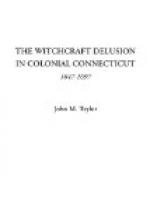Mistress Pell seems to have been the chief spokeswoman, and each member of the committee served in some degree as an inquisitor, or exhorter, not to repentance, but to disclosures. Baited and badgered, warned and threatened, the hapless prisoner protested she was innocent, denied the charges made against her, told one of the committee to “take heed the devile have not you,” and also said, “I must not render evil for evil.... I have sins enough allready, and I will not add this [accusing another] to my condemnation.” And at last in agony of soul she made that pathetic appeal to one of her relentless tormentors, “neuer, neuer poore creature was tempted as I am tempted, pray, pray for me.”
But even after death on the scaffold, the witch-hunters of the day did not refrain from their ghoulish work, but desecrated the remains of Goodwife Knapp at the grave side in their search for witch marks.
All the facts during the imprisonment, execution and burial are set forth in some of the testimonies herewith given, in a chapter of related history (the evidence at the trial not being disclosed in any present record), and all of them marked by a total unconsciousness of their sinister and revolting character.
No case in the history of the delusion in New England is more replete in incidents and apt illustrations, due to their fortunate preservation in the records of a lawsuit involving some of the prominent characters in that drama of religious insanity.
At a magistrate’s court held at New Haven the 29th of May, 1654.
Present.
Theophilus Eaton Esqr, Gouernor.
Mr. Stephen Goodyeare, Dept, Gouernor.
Francis Newman \
Mr. William Fowler } Magistrats
Mr. William Leete /
a suit was heard entitled—
Thomas Staplies of Fairfield, plant’.
Mr Rogger Ludlow late of Fairfield, defendt.
It was brought by an aggrieved husband to recover damages for defamation of the character of his wife. It centered in one of the dramatic incidents at Knapp’s execution. In the last extremity, and in the presence of immediate death, the prisoner came down from the ladder, and asking to speak with Ludlow alone, told him that Goodwife Staplies was a witch.
Some time afterward Ludlow, at New Haven, told the Rev. John Davenport and his wife the story, in confidence, and under the promise of secrecy, but it spread abroad with inevitable accretions, and when it reached Fairfield Thomas Staplies went to law, to vindicate his wife’s character in pounds, shillings, and pence. These are some of the statements and remarkable testimonies:
Attorney Banke’s declaration—Ensigne Bryan’s answer—Davenport’s view of an oath, Hebrews vi,16—His account and conscientious scruples—Mistress Davenport’s forgetfulness—“A tract of lying”—“Indian gods”—Luce Pell and Hester Ward’s visit to the prison—The “search” of Knapp—“Witches teates”—Feminine resemblances—Matronly opinions—Post-mortem evidence— Contradictions—Knapp’s ordeal—“Fished wthall in private”—Her denials— Talk on the road to the “gallowes"




